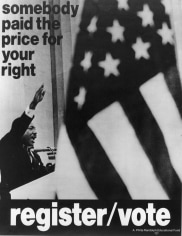
Register to vote poster, 1968 (Courtesy Library of Congress)
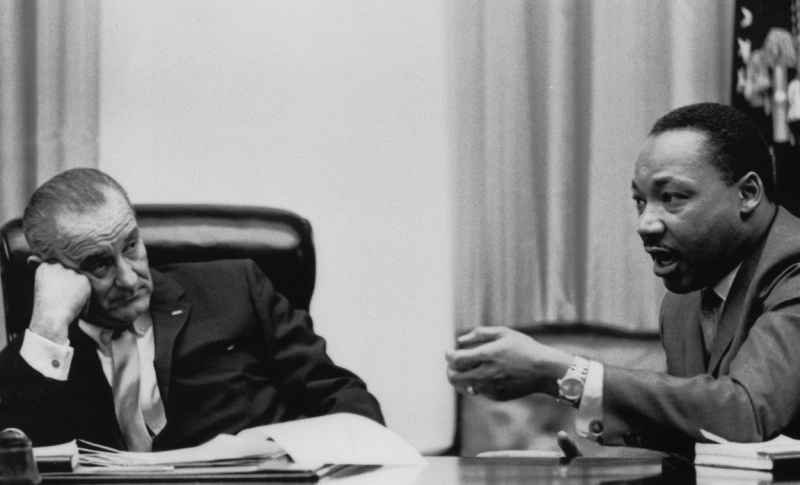
Courtesy of LBJ Library
Essential Question: What can we understand about social movements by studying the strategy, tactics and philosophy of nonviolence?
During the Civil Rights Movement, Dr. Martin Luther King, Jr.’s leadership and commitment to nonviolence was steadfast, yet it was not without challenges from others equally committed to desegregation and racial justice. In this lesson students will learn about the philosophy, strategy, and tactics of nonviolence from the leaders who worked alongside Dr. King and supported his vision, and from those who offered other strategies and tactics for African Americans to achieve full equal rights.
Students will apply the reading skills of sourcing, contextualization, and corroboration of historical content, and broaden their skills and use of close reading strategies by analyzing documentary film, first-person interviews alongside the transcript, and historical images. As a demonstration of learning and assessment, students will write a point of view essay explaining their understanding of nonviolence and the tensions that arose within the leadership of the Civil Rights Movement. Through this process, students will continue to build upon the essential habits of a historian and establish a foundation for critical media literacy.
Materials: Equipment for watching film segments, projecting photographs, and copies of handouts
Length: Two 50-minute class periods plus homework plus a writing assessment
Students will use skills in reading historic content, and increase their understanding of nonviolent philosophy during the Civil Rights Movement by:
*Analyzing primary source materials including photographs and documents
*Critically viewing documentary film and first-person interviews to inform their understanding of the lesson topic
*Synthesizing new learning through developing questions for further historical inquiry
*Demonstrating their understanding of the lesson topic through a final writing exercise
Teacher Note: Have students discuss or respond in writing to these questions:
Understanding Nonviolence: Tactics and Strategy
Explore with students the difference between a philosophy (guiding moral principles) and tactics and strategy (actions that are taken to achieve a goal and the theory to accomplish the goal). Have students use their prior knowledge to build a working definition of nonviolence as a philosophy, and the non-violent strategies and tactics used during the Civil Rights Movement.
Distribute Handout 1: Do Now Exercise: Nonviolence in "Resources" section. Have students read and discuss the three quotes on the handout and then return to the class definition. Add further ideas to the class’s working definition of the philosophy of nonviolence.
Distribute Handout 2: The Philosophy of Nonviolence Note Catcher in "Resources" section. Review the Note Catcher questions to help students watch the film clips actively and with critical eyes. You may choose to watch the clips more than once so students can collect detailed notes.
Watch Clip One:"Sick and Tired of Violence" (run time: 9:17) followed by Clip Two: "The Nonviolent Approach is Radical" (run time: 7:02). Both are in the "Film Clips" section. These clips are rich in content so try to leave time between each for students to collect their thoughts and notes.
Habit of a Historian
After watching the two film clips, have students write down any questions that revolve around the philosophy, strategy, or tactics of nonviolence.
Teacher Note: The film-makers conducted 19 interviews to produce King in the Wilderness. The complete interviews and academic notes for each interviewee are available at www.kunhardtfilmfoundation.org/interview-archive.
For each lesson, interview segments that were not used in the film, but contain insights relevant to the lesson topic, are edited together to create “interview threads.“ There are three Interview Threads in this lesson that teachers and students can choose from, or use together, to deepen their understanding.
Print and distribute Handouts 3, 4 and 5 in the "Resources" section. Students can review all three interviews with the transcripts individually, in small groups, or as a jigsaw activity.
Watch the Interview Threads
As they watch, students will:
* Follow along on the transcript.
* Underline details that catch their attention.
* Jot down questions and insights that come to mind after viewing the threads.
Thread One: "Nonviolence" (run time: 12:32)
Featuring Diane Nash, C.T. Vivian, and Bernard Lafayette
Thread Two: "Nonviolence as a Tactic" (run time 7:36)
Featuring Jesse Jackson, Mary Lou Finley, and Cleveland Sellers
Thread Three: "Respecting Different Views" (run time 4:12)
Featuring Marian Wright Edelman and Andrew Young
Discuss:
* What do we learn from these first-person accounts featured in the interview threads that are different from other kinds of historical sources?
* What questions arise from listening to other viewpoints on nonviolence?
Teacher Note: Students will use visual analysis skills to “read” visual sources as if they were employing literary analysis skills. Project or print and distribute the photographs under the “Images” title on this page and have students discuss the questions in small groups.
*What do you see happening in each photograph?
*What story about nonviolence does each individual picture tell?
*What larger story about nonviolence do the pictures tell when viewed after your analysis of the film and interview threads?
*What questions would you ask the photographers about these photos?
*How can we know that these images are accurate?
*Do you trust what you see in the images? Why or why not?
After watching the film and interviews and then analyzing photographs focusing on nonviolence from the time period, have students write down thoughts or questions that probe their new understanding about nonviolence.
Teacher Note: After viewing and reading the interview threads, have students choose one or more historical detail to practice their habit of sourcing and corroborating - in other words, research and identify a credible historical source that will verify the detail they selected from the interview. Here are some questions to keep in mind:
* Where did you find the document? Is it credible? How do you know?
* What is the date and who is the author? When is this important?
* How does the source confirm the detail selected from the interview?
* What other sources can you use to help you better understand memories and recollections as a historical resource?
Here are suggested archives to use to find corroborating evidence:
1. The King Center
2. Stanford University: The Martin Luther King, Jr. Research and Education Institute
3. Library of Congress
Discuss:
*What new information did you learn about nonviolence from the first-person interviews?
Habit of a Historian
After completing the lesson, have students note what answers they found to previous questions, or identify new questions they’d like to explore.

Register to vote poster, 1968 (Courtesy Library of Congress)
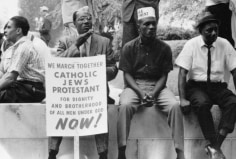
Civil rights march from Selma to Montgomery, Alabama, March 1965 (Courtesy Library of Congress)
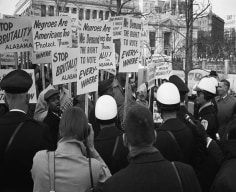
Civil Rights demonstrators outside the White House, Washington D.C., March 12, 1965 (Courtesy Library of Congress)
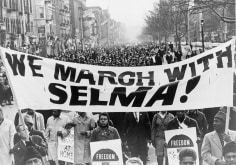
Civil Rights march, Harlem, New York, March 1963 (Courtesy Library of Congress
“This I Believe” Point of View Essay
Taylor Branch, a Pulitzer-Prize winning author and scholar on Martin Luther King, Jr., who also conducted interviews for King in the Wilderness, writes a compelling opening paragraph on nonviolence in At Canaan’s Edge: America in the King Years 1965-68.
"Nonviolence is an orphan among democratic ideas. It has nearly vanished from public discourse even though the most basic element of free government--the vote--has no other meaning. Every ballot is a piece of nonviolence, signifying hard-won consent to raise politics above firepower and bloody conquest. Such compacts work more or less securely in different lands. Nations gain strength from vote-based institutions in commerce and civil society, but the whole architecture of representative democracy springs from the handiwork of nonviolence."
We also heard echoes of this idea of the power of the vote from others both in the documentary and within The Interview Archive.
“You, that is King, would not say to the parishioners, ‘You better go out there and vote for Lyndon Johnson.’ That's not what he did. He would go out and say why you have your responsibility to vote, what it is that the vote does, see what we've gotten as a result of showing our power at the ballot
box, and reiterating this message which was then taken by the people who listened to it other places.” - Alexander Clifford, King in the Wilderness
“Resisting means some kind of boycott, some kind of action. The weapons we use --one, the effective use of one’s vote, one’s dollar, coalition, action, and to be morally right. Those are the weapons that you use, because, at the end of the day, our biggest weapon is to be mostly morally right. Ms. Parks was mostly right. Those who marched in Birmingham were mostly right. Those who marched for the right to vote were mostly morally right. We couldn’t impose wrong on anybody. We had, in fact, to assert the rightness of our cause and the righteousness of our cause and be willing to suffer and sacrifice at the end. And nonviolence was both a strategy and a way of life. If we had been fighting with arms, we couldn't have battled in arms. But then Doctor King said, ‘If you shoot and you get shot, then there are no winners, but if you can change without shooting, getting shot, then both can survive for another day.’” -Rev. Jesse Jackson, King in the Wilderness
As an assessment assignment, have students write a “This I Believe” essay of between 500 and 600 words explaining what they believe about nonviolence using one of these three passages as a point of departure.
Anchor Standards
Reading Literature and/or Information: Integration of Knowledge and Ideas
RL/RI.X.7. Integrate and evaluate content presented in diverse media and formats, including visually and quantitatively, as well as in words.
RL/RI.X.8. Delineate and evaluate the argument and specific claims in a text, including the validity of the reasoning as well as the relevance and sufficiency of the evidence.
RL/RI.X.9. Analyze how two or more texts address similar themes or topics in order to build knowledge or to compare the approaches the authors take.
Speaking and Listening: Comprehension and Collaboration
SL.X.1. Prepare for and participate effectively in a range of conversations and collaborations with diverse partners, building on others’ ideas and expressing their own clearly and persuasively.
SL.X.2. Integrate and evaluate information presented in diverse media and formats, including visually, quantitatively, and orally.
SL.X.3. Evaluate a speaker’s point of view, reasoning, and use of evidence and rhetoric.
Writing: Research to Build and Present Knowledge
W.X.7. Conduct short as well as more sustained research projects based on focused questions, demonstrating understanding of the subject under investigation.
W.X.8. Gather relevant information from multiple print and digital sources, assess the credibility and accuracy of each source, and integrate the information while avoiding plagiarism.
